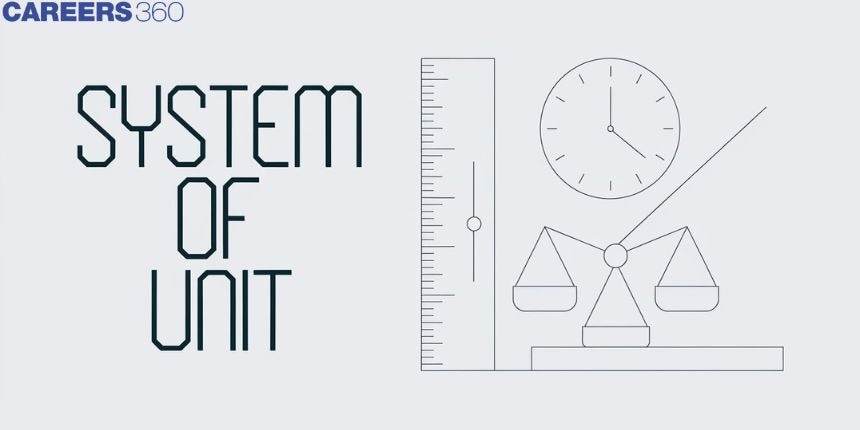System Of Unit
Think about the way that you measure ingredients to cook or the way you calculate distances and fuel efficiency in your car, or maybe even the way that you monitor your exercise. In each of these activities you use a system of units, that is a collection of units with which you quantify some aspect of the world. A system of units standardizes measurements so it is that the same measurements are the same everywhere, at all times and for everyone.
This Story also Contains
- System Of Unit
- Solved Example Besed On System Of Unit
- Summary

In this article, we will cover the concept of the system of units. This concept we study in the chapter of physics and measurement which is a crucial chapter in Class 11 physics. It is not only essential for board exams but also for competitive exams like the Joint Entrance Examination (JEE Main), National Eligibility Entrance Test (NEET), and other entrance exams such as SRMJEE, BITSAT, WBJEE, VITEEE and more. Over the last ten years of the JEE Main exam (from 2013 to 2023), a total of one question has been asked on this concept. But no direct question in NEET.
System Of Unit
A complete set of units, for all kinds of physical quantities (both fundamental and derived ), is known as a system of units.
Now discuss about the types of system of unit:
- C.G.S. system- In this system, fundamental units are centimetres (cm), grams (g) and second (s).
- M.K.S. System- In this system, fundamental units are meter(m), kilogram(kg) and second (s).
- F.P.S. system- In this system foot(ft), pound(lb) and second(s) are used for measurement of length, mass and time respectively.
- S.I. System- It is known as the International System of Units. There are seven fundamental quantities in this system. It is the modification of the m.k.s system
| Fundamental Quantity | Fundamental Unit | Symbol |
| Length | meter | m |
| Mass | kilogram | kg |
| Time | second | s |
| Electric current | ampere | A |
| Temperature | kelvin | K |
| Amount of substance | mole | mol |
| Luminous intensity | candela | cd |
Recommended Topic Video
Solved Example Besed On System Of Unit
Example 1: Choose the option which contains the correct pair of quantities with its fundamental unit in the SI system.
1) Mass- Gram
2) Mass- Kilogram
3) Time- Hour
4) Length- Centimeter
Solution:
The mass has a fundamental unit- a kilogram
Time has a fundamental unit- second
Length has fundamental unit- meter
Hence, the answer is option (2).
Example 2: In the SI system fundamental unit for temperature is :
1) Degree
2) Celsius
3) Kelvin
4) Radian
Solution:
The temperature has an SI unit of Kelvin.
which is represented by the symbol K.
Hence, the correct option is (3).
Example 3:Match List - I with List - II.
List-I List-II (a)RH( Rydberg constant )( i )kgm−1 s−1( b h( Planck's constant ) (ii kgm2 s−1 (c) μB( Magnetic field energy density )( iiii )m−1 (d) η( coefficient of viscocity )( iv )kgm−1 s−2
Choose the most appropriate answer from the options given below :
1) (a)−(iii),(b)−(ii),(c)−(iv),(d)−(i) 2) (a)−(ii),(b)−(iii),(c)−(iv),(d)−(i) 3) (a)−(iii),(b)−(ii),(c)−(i),(d)−(iv) 4) (a)−(iv),(b)−(ii),(c)−(i),(d)−(iii)
Solution:
SI unit of RH:m−1
SI unit of h:kgm2 s−1
SI unit of η:kgm−1 s−1
Hence, the answer is the option (1).
Example 4:Which of the following statements is true about the International System of Units (SI)?
1)The SI is a system of units based on the British imperial system.
2)The SI has only one set of units for all physical quantities.
3)The SI is defined by a set of seven base units from which all other units are derived.
4)The SI has no prefixes for multiples or submultiples of units.
Solution:
The International System of Units (SI) is defined by a set of seven base units, from which all other units are derived. The base units are the metre (length), kilogram (mass), second (time), ampere (electric current), kelvin (temperature), mole (amount of substance), and candela (luminous intensity).
Hence, the answer is the option (3).
Example 5: Which of the following is a derived SI unit?
1) Kelvin (K)
2) Meter (m)
3) Newton (N)
4) Ampere (A)
Solution:
The International System of Units (SI) includes both base units and derived units. Kelvin (K) is a base unit for temperature, Meter (m ) is a base unit for length, and Ampere (A) is a base unit for electric current. Newton ( N ), on the other hand, is a derived unit for force. It is derived from the base units: kilogram ( kg ), meter ( m ), and second ( s ), specifically N=kg⋅m⋅s−2 (kilogram meter per second squared). Therefore, Newton (N) is a derived SI unit, making option 3 the correct answer.
Hence, the answer is the option (3).
Summary
In short, a System of units is a set of units which are used to measure different physical quantities. Most countries use the SI system, which provides a group of fundamental units, such as the meter for length, the kilogram for mass, and the second for time. To these, they are added derived units, like the Newton for force and the joule for energy. Systems of units serve to make order in the measurements across many disciplines and applications. They enable unambiguous communication, comparison, and reproduction of scientific results. This is also what makes everyday activities such as shopping, cooking, or travelling possible because it provides one with a common standard to measure quantities.